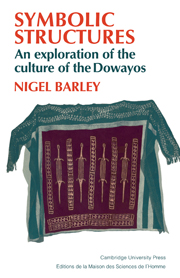Book contents
- Frontmatter
- Contents
- Acknowledgments
- Preface
- 1 The ethnographic background
- 2 Symbolism and the punctuation of culture
- 3 Some problems of the representational model of symbolism
- 4 The leopard cannot change his spots
- 5 Water and fertility
- 6 Tarniisnohgbarklele: ‘the place where the old Fulani woman was beaten to death’
- 7 ‘It is only thanks to me that you were circumcised’
- 8 The seasons of the year and the joker in the pack: relations of nesting and quotation
- Appendix: The festivals
- Notes
- Bibliography
- Index
6 - Tarniisnohgbarklele: ‘the place where the old Fulani woman was beaten to death’
Published online by Cambridge University Press: 07 May 2010
- Frontmatter
- Contents
- Acknowledgments
- Preface
- 1 The ethnographic background
- 2 Symbolism and the punctuation of culture
- 3 Some problems of the representational model of symbolism
- 4 The leopard cannot change his spots
- 5 Water and fertility
- 6 Tarniisnohgbarklele: ‘the place where the old Fulani woman was beaten to death’
- 7 ‘It is only thanks to me that you were circumcised’
- 8 The seasons of the year and the joker in the pack: relations of nesting and quotation
- Appendix: The festivals
- Notes
- Bibliography
- Index
Summary
Myth 3
An old Fulani woman had a son. He was ill. He had run in the silkoh grass and cut himself. His penis swelled up and was full of pus. She took a knife and cut so the child was cured. The penis became beautiful. She cut her second son. One day she went for a walk through a Do way o village and the Dowayos saw it was good. They took circumcision and beat her to death. That was how it started because Dowayos did not know circumcision. They forbade women to see it. But Fulani women can see it. It is finished.
The killing of the old Fulani woman is re-enacted on several occasions. At the end of the ‘sticking of the bow’ rites where a man's bow is fixed behind the skull-house, his brothers, brothers of circumcision and the clown assemble, naked except for penis sheaths, before the ddre. The clown puts on leaves and adopts the high-pitched, bad-tempered tone of an old woman. At the back he wears a long tail of borassus leaves that trail along the ground. On his head he carries a basket. His ‘husband’ is with him urging him along. Other men crouch down with sticks.
‘What are those black things in the road?’ asks the old woman.
‘It is nothing. They are cattle.’
‘I am frightened, it's getting dark.’
‘There's no need to be frightened. I have my bow.’
The couple pass three times between the men. On the fourth time, the men leap up with a cry and beat the ‘tail’ with their sticks. This may be seen by men only. Even boys are excluded.
- Type
- Chapter
- Information
- Symbolic StructuresAn Exploration of the Culture of the Dowayos, pp. 60 - 69Publisher: Cambridge University PressPrint publication year: 1983

